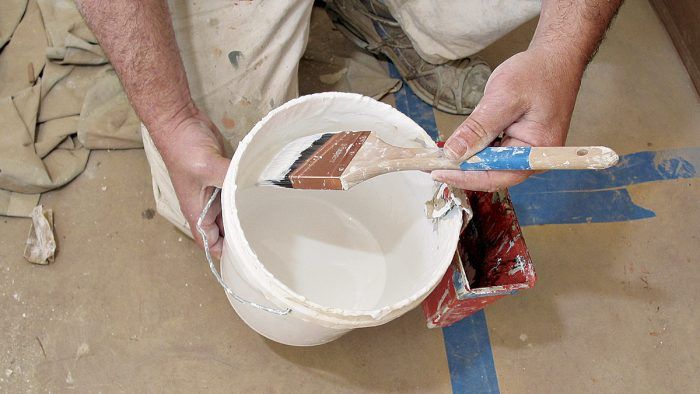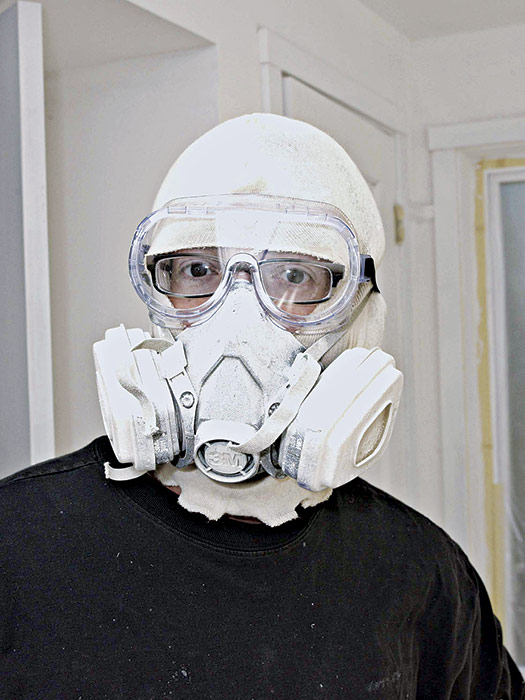
Painting is probably the most popular renovation task because its effects are immediate and striking. For not much money, you can get a complete change of scenery and heart. If you own a few basic tools, your costs will be limited to the few tools you’ll need to rent and the paint you choose.
A quality paint job takes preparation, patience, and experience. In addition, professionals also learn how to streamline their moves. As one pro put it, “Any time you eliminate a move in painting, you save time.”
Painting safely
Almost all paints, including latex, contain VOCs, which are hazardous. The following advice is pertinent for all kinds of paints and stains.
Read the label. There’s valuable information on all paint containers: drying time, coverage, thinner data (what to use and how much), and safety instructions. Should an emergency arise—say, a child swallows some paint—the guidance you need may later be concealed under paint drippings. So read up before you open the can or, better, remove and save the label.

Don’t breathe paint fumes. Breathing paint or solvent fumes can make you dizzy, impair your judgment, and, over a sustained period, damage your brain, lungs, and kidneys. Set up a fan to blow fumes away from your work area, and always wear a half-face respirator with replaceable cartridges. Rule of thumb: If you can smell fumes while wearing a snug mask, change the cartridge.
Ventilation is a particular problem when chemically stripping paints because the chemicals are strong and because heat guns, sanders, and scrapers increase airborne particles. The now banned lead-based paints are especially dangerous when inhaled or ingested, so if you suspect that you will be stripping lead paint, always test it before disturbing it. Read the article Lead-Paint Safety for detailed information about testing for and dealing with lead paint.
Protect your eyes and skin. Although most water-based paints are innocuous, oil-based paints can be extremely irritating. In most cases, flush your eyes with water if you get paint in them, and visit a doctor immediately.
There are a few things you can do to protect your skin. Before you start, apply lotion to your skin to reduce irritation and speed cleanup. Also, wear gloves, even when using latex, because any paint will irritate skin over time. Gloves are a must for oil-based paints.
When it comes to cleanup, painters have traditionally used paint thinner or turpentine to clean their hands and then washed with hot, soapy water. However, hot water opens skin pores, causing them to absorb more solvent. Instead of volatile solvents and hot water, it may be safer to use waterless hand cleaner and wipe it off with paper towels.
Store paint safely. Store paint where children can’t reach it. Solvents such as paint thinner, turpentine, and all paints—including latex—should be considered toxic and stored out of reach of children. (Some “green” brands of latex such as Benjamin Moore Natura and AFM Safecoat contain no VOCs, but you still wouldn’t want kids to drink them. So store these products safely, too.) Also, store paint where temperatures are moderate because freezing ruins their bonding ability and heat increases their volatility. Close all containers completely so the paint doesn’t dry out and contaminants can’t get in. Never store rags or steel wool dirty with solvents because of the danger of spontaneous combustion. Dispose of such articles safely: Most paint-can labels carry disposal suggestions, and many municipalities have annual curbside pickups of such materials.
Essential Prep WorkIf you want painted surfaces to look good and last long, the substrate—such as drywall, plaster, and wood—must be stable and dry before you start. Prep work is crucial for a good paint job. Whether you’ll be painting a building’s interior or exterior, follow these guidelines:
|
Brush basics
The pros work steadily and methodically and note what works and what doesn’t. The following tips will help you keep the job moving and get great results.
Acclimate a new brush. Stand a new brush in 1 in. of oil-based paint for five minutes. After absorbing a bit of paint, the new bristles will release paint more readily when you start to work, whereas thirsty new brushes may drag at first. It’s not necessary to acclimate brushes when using latex, which works into bristles within 20 to 30 seconds.
Avoid overloading your brush. Pros have only 1/2 in. to 1 in. of paint in the bottom of a paint pail when edging—and the same amount on the tip of the brush. With this small amount, you’ll cut a cleaner paint line and keep paint off the brush handle and your hands. Should the bucket tip over, you’ll have less mess to clean up.
Retrieve loose bristles. If a bristle comes loose and sticks to the surface, pick it out by dabbing lightly with the tip of the brush. Quality brushes rarely lose bristles.
Paint with gravity. This is close to an absolute rule. Paint, as a liquid or mist, always falls or drips downward, so it’s better if it lands on unpainted surfaces—rather than painted ones. Best sequence: ceilings, walls, trim, baseboards.
Paint with the grain. When painting trim, brush paint in the direction of the wood grain. Painting cross-grain doesn’t help paint adhere better and will look terrible if brushstrokes dry quickly.
Steady hand, straight paint. Few pros use masking tape to achieve straight lines when brushing paint onto trim, window casing, and the like. Pros feel that tape takes too much time to apply and sometimes lets the paint seep under, leaving a ragged line. Besides, during removal, tape can pull off paint. Patience and a steady hand work better. With a little practice, it’s easier than you might think.
Roller basics
Acclimate roller covers to paint. Work paint into a new roller cover before using it. Load the cover with paint. Then roll it up and down the paint ramp to work the paint down to the base of its nap, and remove the excess.
Roll upward, after loading a roller with paint. If you roll downward instead, you’ll be more likely spray excess paint onto walls and floors. Instead, with an initial upstroke, excess falls back onto the roller cover.
Roll paint in a zigzag. Roller covers contain the most paint during the first three to five passes, so first roll a W or an N to distribute “fat paint,” which you can then reroll to spread the paint evenly.
Lighten up once the paint is spread on the wall. Especially on outside corners (corners that project into a room), don’t bear down on the roller. Too much pressure can make the roller skid or leave roller-edge marks.







